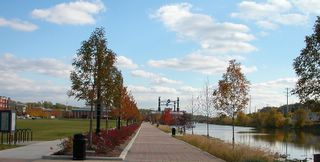A couple more thoughts/questions on the proposed Wal-Mart on Randall Road. Is the property already incorporated? If not, is it substantially contiguous to South Elgin such that there's a possibilty of it being annexed to South Elgin if Elgin doesn't agree to the development in its current form? If the city is in a strong negotiating position, I think it might consider asking for an additional Wal-Mart on Summit on the east side, at that empty lot just west of the Jewel-Osco plaza (see map). That lot has been empty forever--it's a blight, and it's large enough for a Wal-Mart. I think people on the east side would appreciate a Wal-Mart; Wal-Mart would do very good business there; and the city would get tax revenues that would otherwise go to Dundee. Shouldn't we at least ask for a feasibility/market study for an additional Wal-Mart store on that Summit site or another site on the east side before we agree to one on Randall?
The Chicago Tribune also ran an article on the debate.
The Chicago Tribune also ran an article on the debate.
"This deal concerns me," council member Thomas Sandor said Wednesday. "This is one of Elgin's last prime pieces of property on Randall Road. When I look north to Algonquin or south to South Elgin and Geneva, I see upscale, high-end retail, and Elgin gets discount stores?"
Plans for the 73-acre site at Randall and Bowes Roads include a 196,000-square-foot Wal-Mart Super Center with a grocery, a 138,500-square-foot Sam's Club and gas station, and nine retail outlots.
The City Council is expected to revisit the proposal Feb. 22.
